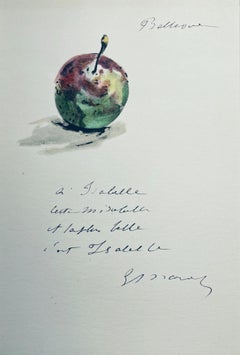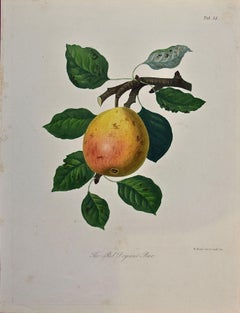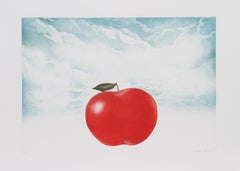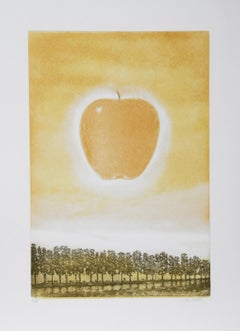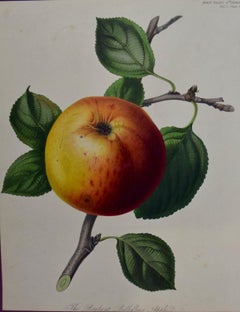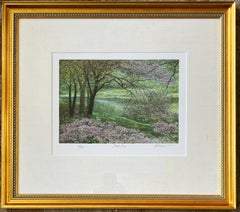Apple Landscape Prints
to
1
4
3
Overall Width
to
Overall Height
to
2
1
1
1
1
1
2
5
1
2
1
5
2
281
6,787
3,401
2,650
2,298
1,840
1,614
1,547
1,407
1,258
1,067
1,037
961
904
863
834
713
579
530
530
3
2
2
2
1
7
Art Subject: Apple
Manet, Composition, Édouard Manet, Letters with Aquarelles (after)
Located in Southampton, NY
Lithograph and stencil on vélin Foreign Affairs paper mounted on Foreign Affairs museum board, as issued . Unsigned and unnumbered, as issued. Good Condition. Notes: From the folio, Édouard Manet, Letters with Aquarelles, 1944. Published by Pantheon Books, New York; rendered and printed by Raymond and...
Category
1940s Impressionist Figurative Prints
Materials
Lithograph
$716 Sale Price
20% Off
Red Doyenne Pear: Original 19th C. Hand-colored Engraving by Sir William Hooker
Located in Alamo, CA
This is an original 19th century hand-colored stipple engraving by William Hooker entitled "The Red Doyenne Pear", published in London as plate 14 in the 'Transactions of the Horticu...
Category
1810s Naturalistic Still-life Prints
Materials
Engraving
Apple Orchard
Located in San Francisco, CA
This artwork titled "Apple Orchard" 1998, is a color off set lithograph by British/American artist Pati Bannister, 1929-2013. It is hand signed, titled a...
Category
Late 20th Century Romantic Figurative Prints
Materials
Lithograph
Ripe Sky, Surrealist Aquatint Etching by Hank Laventhol
Located in Long Island City, NY
Hank Laventhol, American (1927 - 2001) - Ripe Sky, Year: circa 1980, Medium: Aquatint Etching, signed and numbered in pencil, Edition: 300, Image Size: 16 x 24 inches, Size: 22 ...
Category
1980s Surrealist Landscape Prints
Materials
Etching, Aquatint
Golden Apple, Surrealist Aquatint Etching by Hank Laventhol
Located in Long Island City, NY
Hank Laventhol, American (1927 - 2001) - Golden Apple, Year: circa 1980, Medium: Aquatint Etching, signed and numbered in pencil, Edition: 300, AP XXXV, Image Size: 24 x 16 inche...
Category
1980s Surrealist Landscape Prints
Materials
Aquatint, Etching
Brabant Apple: A 19th Century Hand-colored Engraving by Augusta Innes Withers
By Augusta Innes Withers
Located in Alamo, CA
This early 19th century hand-colored stipple engraving by Augusta Innes Withers entitled "The Brabant Bellefleur Apple" was plate 10 published in London in the 'Transactions of the H...
Category
1810s Naturalistic Still-life Prints
Materials
Engraving
Holiday Pine Cones
Located in New Orleans, LA
This Holiday wreath adorns the door of a Brooklyn Mansion
Frederick Mershimer (American, b. 1958)
Moody, mysterious, majestic – these are some of the ways to describe the mezzotint...
Category
1990s American Modern Landscape Prints
Materials
Mezzotint
Related Items
Duck Pond
Located in San Francisco, CA
Artist: Harold Altman (American, 1924-2003)
Title: Duck Pond
Year: circa 1980
Medium: Original color lithograph
Edition: 285. This one: 29/285 in pencil
Paper: Arches
Image size...
Category
Late 20th Century American Impressionist Landscape Prints
Materials
Lithograph
La Cote d'Azur
Located in San Francisco, CA
This artwork titled "La Cote d'Azur" c.1980, is an original colors lithograph on watermarked Arches paper by noted French artist Jean Claude Picot, 1933-2020. It is hand signed and ...
Category
Late 20th Century Impressionist Landscape Prints
Materials
Lithograph
Parc Monceau, Paris
Located in San Francisco, CA
Artist: Harold Altman (American, 1924-2003)
Title: Parc Monceau, Paris
Year: c.1985
Medium: Color lithograph
Edition: Inscribed H.C. (Hors Commerce) ...
Category
Late 20th Century American Impressionist Landscape Prints
Materials
Lithograph
Dust Time, large lithograph
By John Maxon
Located in San Francisco, CA
Artist: John Maxon (American, born 1947)
Title: Dust Time
Year: 1993
Medium: Color lithograph
Edition: Numbered 146/210
Paper: Arches
Image size: 26.5 x 39.75 inches
Paper size: 31.5 x 44 inches
Signature: Hand signed in pencil by the artist
Condition: Excellent, has never been framed
About the artist.
Coming from a very western tradition in Wyoming, John Maxon developed an expansive view of nature . Moving eventually to the San Francisco Bay area, John's delight in the effects of light and color led him to the decision to become an artist at the young age of 15. His natural ability was encouraged, and at 16 he began figurative art classes with Howard Brodie, the artist well known for his WWII correspondence, drawings and the Watergate trial drawings.
Education
San Francisco Art Institute
B.A., Painting, San Jose State University
M.F.A., Painting, University of California, Davis
Stanford University, Palo Alto, California
Cabrillo College, Aptos, California
Selected Solo Exhibitions
2018
Gallery Panza Verde – Antigua Guatemala, Guatemala
2015
Desert Art Collection - Palm Desert California
2015
Galeria Antigua – Antigua, Guatemala
2014
Galeria Panza Verde – Antigua, Guatemala
2008
Linda Durnell Gallery – Los Gatos, California
2006
Linda Durnell Gallery – Los Gatos, California
2005
Robert Allen Fine Art Gallery – Sausalito, California
2004
Ellis West Gallery – Durango, Colorado
2002
Ellis West Gallery – Durango, Colorado
2001
Robert Allen Fine Art Gallery – Sausalito, California
1997
Stanford University Faculty Club – Stanford, California
Selected Group Exhibitions
2018
Chemers Art Gallery – Los Angeles, California
2009, 2010, 2016, 2017 & 2018
Robert Allen Fine Art – Sausalito, California
2017 Christopher Hill Gallery - St Helena, California
2013 / 19
Gallery North - Carmel, California
2015
Desert Art Collection - Palm Desert, California
2014
Paul Scott Gallery - Bend, Oregon
2014
Christopher Hill Gallery Healdsberg, California
2013
Firehouse Art Center - Pleasanton, Ca. 2013
2011 - 2013
Robert Allen Fine Art – Sausalito, California
2010 - 2012
Susan Street Gallery – Solano Beach, California
2010 (Awarded 1st place) and 2012
“Contemporary Landscape Painters of California” – Awarded 1st Place
2011 - 2012
Salisbury Fine Art – Avila Beach, California
2010
Bryant Street Gallery – Palo Alto, California
2009
Museum Art and History – Santa Cruz, California
2008
Cabrillo College – Aptos, California
2006
Christopher Hill Gallery – St. Helena, California
2005
Fort Lewis College – Durango, Colorado
2001
St. Supery Winery & Fine Art Gallery, Napa California
2001
Napa Valley Wine Auction – St. Helena, California
1997
West Coast Painting and Sculpture – Ocean Side, California
1997
Wolk Gallery – St. Helena, California
Selected Museum Collections
Interior Museum, Department of the Interior, Washington D. C.
Santa Cruz County Art Museum – Santa Cruz, California
University of California – Berkeley, California
University of California – Davis, California
Napa Valley Art...
Category
Late 20th Century American Impressionist Landscape Prints
Materials
Lithograph
Rio Osmarin (boats on the canal Rio de S. Provolo o de l'Osmarin, Venice)
Located in New Orleans, LA
Rio Osmarin shows boats on the canal Rio de S. Provolo o de l'Osmarin in Venice) It was created in 2006 and this impression is #31 of 75 It is signed, titled, numbered and dated by...
Category
21st Century and Contemporary American Modern Still-life Prints
Materials
Mezzotint
$110 Sale Price
61% Off
H 6.75 in W 5 in
Destinations (Flatiron Bidg, 5th Avenue and Broadway at 23rd Street)
Located in New Orleans, LA
In "Destinations", Frederick Mershimer creates an image of taxis rushing by the Fuller Building, better known as Flatiron Building. The building is only six feet wide at its rounded...
Category
1990s Contemporary Landscape Prints
Materials
Mezzotint, Aquatint
$2,500
H 11.57 in W 9.63 in
19th century color lithograph figures cemetery willow tree memorial headstone
Located in Milwaukee, WI
The present hand-colored lithograph was produced as part of the funeral and mourning culture in the United States during the 19th century. Images like this were popular as ways of remembering loved ones, an alternative to portraiture of the deceased. This lithograph shows a man, woman and child in morning clothes next to an urn-topped stone monument. Behind are additional putto-topped headstones beneath weeping willows, with a steepled church beyond. The monument contains a space where a family could inscribe the name and death dates of a deceased loved one. In this case, it has been inscribed to a young Civil War soldier:
William W. Peabody
Died at Fairfax Seminary, VA
December 18th, 1864
Aged 18 years
The young Mr. Peabody probably died in service for the Union during the American Civil War. Farifax Seminary was a Union hospital and military headquarters in Alexandria, Virginia. The hospital served nearly two thousand soldiers during the war time. Five hundred were also buried on the Seminary's grounds.
13.75 x 9.5 inches, artwork
23 x 19 inches, frame
Published before 1864
Inscribed bottom center "Lith. & Pub. by N. Currier. 2 Spruce St. N.Y."
Framed to conservation standards using 100 percent rag matting and TruVue Conservation Clear glass, housed in a gold gilded moulding.
Nathaniel Currier was a tall introspective man with a melancholy nature. He could captivate people with his piercing stare or charm them with his sparkling blue eyes. Nathaniel was born in Roxbury, Massachusetts on March 27th, 1813, the second of four children. His parents, Nathaniel and Hannah Currier, were distant cousins who lived a humble yet spartan life. When Nathaniel was eight years old, tragedy struck. Nathaniel’s father unexpectedly passed away leaving Nathaniel and his eleven-year-old brother Lorenzo to provide for the family. In addition to their mother, Nathaniel and Lorenzo had to care for six-year-old sister Elizabeth and two-year-old brother Charles. Nathaniel worked a series of odd jobs to support the family, and at fifteen, he started what would become a life-long career when he apprenticed in the Boston lithography shop of William and John Pendleton.
A Bavarian gentleman named Alois Senefelder invented lithography just 30 years prior to young Nat Currier’s apprenticeship. While under the employ of the brothers Pendleton, Nat was taught the art of lithography by the firm’s chief printer, a French national named Dubois, who brought the lithography trade to America.
Lithography involves grinding a piece of limestone flat and smooth then drawing in mirror image on the stone with a special grease pencil. After the image is completed, the stone is etched with a solution of aqua fortis leaving the greased areas in slight relief. Water is then used to wet the stone and greased-ink is rolled onto the raised areas. Since grease and water do not mix, the greased-ink is repelled by the moisture on the stone and clings to the original grease pencil lines. The stone is then placed in a press and used as a printing block to impart black on white images to paper.
In 1833, now twenty-years old and an accomplished lithographer, Nat Currier left Boston and moved to Philadelphia to do contract work for M.E.D. Brown, a noted engraver and printer. With the promise of good money, Currier hired on to help Brown prepare lithographic stones of scientific images for the American Journal of Sciences and Arts. When Nat completed the contract work in 1834, he traveled to New York City to work once again for his mentor John Pendleton, who was now operating his own shop located at 137 Broadway. Soon after the reunion, Pendleton expressed an interest in returning to Boston and offered to sell his print shop to Currier. Young Nat did not have the financial resources to buy the shop, but being the resourceful type he found another local printer by the name of Stodart. Together they bought Pendleton’s business.
The firm ‘Currier & Stodart’ specialized in "job" printing. They produced many different types of printed items, most notably music manuscripts for local publishers. By 1835, Stodart was frustrated that the business was not making enough money and he ended the partnership, taking his investment with him. With little more than some lithographic stones, and a talent for his trade, twenty-two year old Nat Currier set up shop in a temporary office at 1 Wall Street in New York City. He named his new enterprise ‘N. Currier, Lithographer’
Nathaniel continued as a job printer and duplicated everything from music sheets to architectural plans. He experimented with portraits, disaster scenes and memorial prints, and any thing that he could sell to the public from tables in front of his shop. During 1835 he produced a disaster print Ruins of the Planter's Hotel, New Orleans, which fell at two O’clock on the Morning of the 15th of May 1835, burying 50 persons, 40 of whom Escaped with their Lives. The public had a thirst for newsworthy events, and newspapers of the day did not include pictures. By producing this print, Nat gave the public a new way to “see” the news. The print sold reasonably well, an important fact that was not lost on Currier.
Nat met and married Eliza Farnsworth in 1840. He also produced a print that same year titled Awful Conflagration of the Steamboat Lexington in Long Island Sound on Monday Evening, January 18, 1840, by which melancholy occurrence over One Hundred Persons Perished. This print sold out very quickly, and Currier was approached by an enterprising publication who contracted him to print a single sheet addition of their paper, the New York Sun. This single page paper is presumed to be the first illustrated newspaper ever published.
The success of the Lexington print launched his career nationally and put him in a position to finally lift his family up. In 1841, Nat and Eliza had their first child, a son they named Edward West Currier. That same year Nat hired his twenty-one year old brother Charles and taught him the lithography trade, he also hired his artistically inclined brother Lorenzo to travel out west and make sketches of the new frontier as material for future prints. Charles worked for the firm on and off over the years, and invented a new type of lithographic crayon which he patented and named the Crayola. Lorenzo continued selling sketches to Nat for the next few years.
In 1843, Nat and Eliza had a daughter, Eliza West Currier, but tragedy struck in early 1847 when their young daughter died from a prolonged illness. Nat and Eliza were grief stricken, and Eliza, driven by despair, gave up on life and passed away just four months after her daughter’s death.
The subject of Nat Currier’s artwork changed following the death of his wife and daughter, and he produced many memorial prints and sentimental prints during the late 1840s. The memorial prints generally depicted grief stricken families posed by gravestones (the stones were left blank so the purchasers could fill in the names of the dearly departed). The sentimental prints usually depicted idealized portraits of women and children, titled with popular Christian names of the day.
Late in 1847, Nat Currier married Lura Ormsbee, a friend of the family. Lura was a self-sufficient woman, and she immediately set out to help Nat raise six-year-old Edward and get their house in order. In 1849, Lura delivered a son, Walter Black Currier, but fate dealt them a blow when young Walter died one year later. While Nat and Lura were grieving the loss of their new son, word came from San Francisco that Nat’s brother Lorenzo had also passed away from a brief illness. Nat sank deeper into his natural quiet melancholy. Friends stopped by to console the couple, and Lura began to set an extra place at their table for these unexpected guests. She continued this tradition throughout their lives.
In 1852, Charles introduced a friend, James Merritt Ives, to Nat and suggested he hire him as a bookkeeper. Jim Ives was a native New Yorker born in 1824 and raised on the grounds of Bellevue Hospital where his father was employed as superintendent. Jim was a self-trained artist and professional bookkeeper. He was also a plump and jovial man, presenting the exact opposite image of his new boss.
Jim Ives met Charles Currier through Caroline Clark, the object of Jim’s affection. Caroline’s sister Elizabeth was married to Charles, and Caroline was a close friend of the Currier family. Jim eventually proposed marriage to Caroline and solicited an introduction to Nat Currier, through Charles, in hopes of securing a more stable income to support his future wife.
Ives quickly set out to improve and modernize his new employer’s bookkeeping methods. He reorganized the firm’s sizable inventory, and used his artistic skills to streamline the firm’s production methods. By 1857, Nathaniel had become so dependent on Jims’ skills and initiative that he offered him a full partnership in the firm and appointed him general manager. The two men chose the name ‘Currier & Ives’ for the new partnership, and became close friends.
Currier & Ives produced their prints in a building at 33 Spruce Street where they occupied the third, fourth and fifth floors. The third floor was devoted to the hand operated printing presses that were built by Nat's cousin, Cyrus Currier, at his shop Cyrus Currier & Sons in Newark, NJ. The fourth floor found the artists, lithographers and the stone grinders at work. The fifth floor housed the coloring department, and was one of the earliest production lines in the country. The colorists were generally immigrant girls, mostly German, who came to America with some formal artistic training. Each colorist was responsible for adding a single color to a print. As a colorist finished applying their color, the print was passed down the line to the next colorist to add their color. The colorists worked from a master print displayed above their table, which showed where the proper colors were to be placed. At the end of the table was a touch up artist who checked the prints for quality, touching-in areas that may have been missed as it passed down the line. During the Civil War, demand for prints became so great that coloring stencils were developed to speed up production.
Although most Currier & Ives prints were colored in house, some were sent out to contract artists. The rate Currier & Ives paid these artists for coloring work was one dollar per one hundred small folios (a penny a print) and one dollar per one dozen large folios. Currier & Ives also offered uncolored prints to dealers, with instructions (included on the price list) on how to 'prepare the prints for coloring.' In addition, schools could order uncolored prints from the firm’s catalogue to use in their painting classes.
Nathaniel Currier and James Merritt Ives attracted a wide circle of friends during their years in business. Some of their more famous acquaintances included Horace Greeley, Phineas T. Barnum, and the outspoken abolitionists Rev. Henry Ward, and John Greenleaf Whittier (the latter being a cousin of Mr. Currier).
Nat Currier and Jim Ives described their business as "Publishers of Cheap and Popular Pictures" and produced many categories of prints. These included Disaster Scenes, Sentimental Images, Sports, Humor, Hunting Scenes, Politics, Religion, City and Rural Scenes, Trains, Ships, Fire Fighters, Famous Race Horses, Historical Portraits, and just about any other topic that satisfied the general public's taste. In all, the firm produced in excess of 7500 different titles, totaling over one million prints produced from 1835 to 1907.
Nat Currier retired in 1880, and signed over his share of the firm to his son Edward. Nat died eight years later at his summer home 'Lion’s Gate' in Amesbury, Massachusetts. Jim Ives remained active in the firm until his death in 1895, when his share of the firm passed to his eldest son, Chauncey.
In 1902, faced will failing health from the ravages of Tuberculosis, Edward Currier sold his share of the firm to Chauncey Ives...
Category
Mid-19th Century Romantic Figurative Prints
Materials
Watercolor, Lithograph
19th century color lithograph watercolor landscape figurative animal print
Located in Milwaukee, WI
The present hand-colored lithograph presents the viewer with a hunting scene in a picturesque landscape. In the foreground, a man approaches two partridges as his two pointers prepare to flush them out. Beyond, a white fence draws our eyes to the homestead in the distance. Images like this one show how people in the United States were trying to identify themselves as a new nation in the North American landscape - as separate from their European counterparts but with similar similar and specific wildlife and magesties of nature. It also identifies hunting in this landscape as an American pastime.
9.25 x 12.5 inches, artwork
18.38 x 22 inches, frame
Entitled bottom center "Partridge Shooting...
Category
Mid-19th Century Romantic Figurative Prints
Materials
Watercolor, Lithograph
Euphorbia, German antique botanical plant chromolithograph print
Located in Melbourne, Victoria
'Euphorbiaceen'
(Euphorbia)
German chromolithograph, circa 1895.
240mm by 155mm (sheet)
Category
Late 19th Century Naturalistic Still-life Prints
Materials
Lithograph
Plymouth Street ( a twilight scene is set in the Brooklyn section of DUMBO)
Located in New Orleans, LA
This view of the Brooklyn and Manhattan Bridges is looking down "Plymouth Street" to the intersection of Jay Street. It is #35 in the catalogue raisonne by Retif & Salzer and is in the permanent collection of the Museum of City of New York...
Category
1990s Contemporary Landscape Prints
Materials
Mezzotint, Aquatint
Frederick MershimerPlymouth Street ( a twilight scene is set in the Brooklyn section of DUMBO), 1990
$2,000
H 8.69 in W 6.07 in
Dune line
By John Maxon
Located in San Francisco, CA
Artist: John Maxon (American, born 1947)
Title:: Dune line
Year: 1994
Medium: Color lithograph
Edition: Inscribed and numbered 15/20
Paper: Arches
Image size: 21 x 33.5 inches
Paper size: 29.25 x 41.5 inches
Signature: Hand signed in pencil by the artist
Condition: Excellent, has never been framed
About the artist.
Coming from a very western tradition in Wyoming, John Maxon developed an expansive view of nature. Moving eventually to the San Francisco Bay area, John's delight in the effects of light and color led him to the decision to become an artist at the young age of 15. His natural ability was encouraged, and at 16 he began figurative art classes with Howard Brodie, the artist well known for his WWII correspondence, drawings and the Watergate trial drawings.
Education
San Francisco Art Institute
B.A., Painting, San Jose State University
M.F.A., Painting, University of California, Davis
Stanford University, Palo Alto, California
Cabrillo College, Aptos, California
Selected Solo Exhibitions
2018
Gallery Panza Verde – Antigua...
Category
Late 20th Century American Impressionist Landscape Prints
Materials
Lithograph
Sunday, Central Park
Located in San Francisco, CA
Artist: Harold Altman (American, 1924-2003)
Title: Sunday, Central Park
Year: c. 1985
Medium: Color lithograph
Edition: Numbered 56/285 in pencil
Paper: Wove
Image size: 17.5...
Category
Late 20th Century American Impressionist Landscape Prints
Materials
Lithograph
